Stone, minerals and semiprecious of the world stone
Amphiboles (silicates): Prehnite -->rus
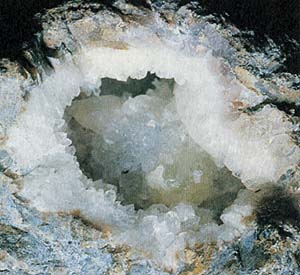 Diagnostic cart.
Diagnostic cart.
On a photo - Prehnite in quartz geode from Tiso, Val-di-Fyunes (province of Boltzano). Down: white plate tablet lamellar Prehnite with the yellow prismatic crystals of Epidote.
Ca2 Al2 (OH)2 Si3O10
Crystal structure rhombic
Hardness on the Mohs scale 6-6,5
Specific unit weight mass 2,8-3
Cleavage perfect absolute
Fracture, break wrong
Colors colourless, polycoloured (multicoloured)
Colors in powder triturate white
Glance (glitter, glare) glassy

PPrehnite - aluminum silicate. Glance (glitter, glare) glassy to mother-of-pearl. Transparent, rarer transparent. Colors: yellow, gold, greenish, white; it is colourless. A line is white. Fracture, break uneven. Cleavage perfect absolute. Appears in cracks and drusy cavities. Crystals (rhombic Crystal structure) are rare, there are plate tablet lamellar, prismatic, but more frequent than all there are fan-shaped joint, junction of platy or needle-shaped individuals. There are twins. Places of distribution: Garc (Germany, Germany), Shvarcvald (Germany), Alps, Scotland.
Usually there are aggregates of crystals. Prehnite is unsteady at heating (carefulness at soldering !). Prenitovyy Cat's Eye is known. Be found in Australia (New Sonth Wales), China, Scotland, Republic of South Africa, USA (state is New Jersey). Entangling Prehnite is possible with a chrysoprase, jade, peridotite.
Now and then Prehnite be found as separate crystals or their little groups. Crystals of plate tablet lamellar or prismatic, quite often with the distorted or deformed verges. Much more frequent, however, there are aggregates of mammiform, kidney-shaped reniform or stalactite form, often radiantly-fibred structure. They can arrive at imposings sizes are to ten of centimetres in a diameter.
As a rule, Prehnite has the colourless or greyish-white colouring, but now and then is painted in green, greenish-grey, yellow-green tones. At some aggregates, colouring is up-diffused unevenly, forming wrong spots. Glance (glitter, glare) glassy, especially at microcrystalline aggregates; quite transparent crystals are more rare.
Crystals are rare, more frequent all of plate tablet lamellar, also prismatic, often bent, collected in groups which remind fans and cockscombs or have a form of ball. Known also conchoidal, shell-shaped, kidney-shaped reniform, spherical aggregates. Cleavage obvious; closeness 2,8-3,0; white, more frequent all of light- or yellowish-green, colourless.
Parameters of elementary cell and number of formula units, and = 4,61, b = 5,47, with = 18,48; Z = 2. Habitus. As crystals be found rarely; usually pseudocube or plate tablet lamellar, parallell {001}; massive, spherical or stalactite with a crystalline surface. Cleavage. To on {001} good. Optical properties. Anisotropic, diaxonic (+), 2V = 60-70o. Indexes of refraction: nр = 1,610-1,637, nm = 1,615-1,647, nq = 1,632-1,673. Khimizm. Fe3+ can substitute for Al3+ to 8% Fe2О3.
Diagnostic indication.
Slowly dissolves in muriatic acid and easily melt fuse in flame of candle, forming bladdery glass mass of white or light-yellow color. Inconspicuous-green is characteristic, but in some standards of white or grey color.
Origin provenance genesis.
Widespread in different rocks, mostly as second mineral. Often be found in the rocks of the first team (foremost in gabbro and diabase, dolerite), amphibolites, crystalline slates; rarer - in emptinesses of granites; now and then it is found in the cracks of granular limestone, marble, limestones and dolomites. Like zeolite, second or hydrothermal product in gas cavities, cracks, geode and veins of native rocks and crystalline slates.
Deposit minefield mine field occurrence subsoil.
If to talk about Italy, Prehnite be found in many alpine areas. Material, suitable for the jeweller use, is set in Prospekt-kuorriz not far from Sidney (Australia), Namakvalende (Sonth-African Republic). Deposit minefield mine field occurrence subsoil: Germany (Pfalc, Shvarcvald, Gessen and other), Austria (Tyrol), France (Dauphin, Pyrenees), Italy, Scotland, USA (the state is New Jersey, rockforming mineral trap, traprock (mountain rock of volcanic origin); ore district of lake Overhead, with zeolite and native copper). The transparent crystals of quality of jewels are found in New Sonth Wales (Australia), China, Scotland, South Africa, USA.
Use is on jeweller business.
Cutting in cabochon, which exposes the effect of iridescentness, is widely used. From the great number of copies of this semiprecious stone spheres and polished purveyances get, in addition, for making of pendants and necklace. Now and then, if it is succeeded to get a transparent crystal, it is processed fasings, usually by a plate or step cutting. Entail or shallow sculpture make out of very dense and homogeneous aggregates.
The first documentarily confirmed mention about a mineral behaves to to 1777, when the French mineralogist B.Zh. Sazh described transparent mass of chrysolite from the cape of Kind Nadezhda. In 1783 g, Dutch colonel Van Pren brought mineral from South Africa to Germany, where Werner defined him as the new gave him the name. Transparent crystals are now polished as jewels. Similar minerals: Vavvelit, thomsonite, stilbite, heulandite can be similar with Prehnite; polished as cabochon, Prehnite looks like a chrysoprase, jade, peridotite.

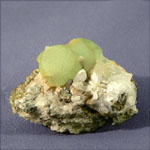
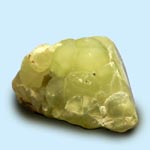
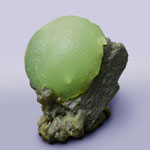
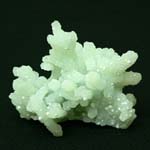
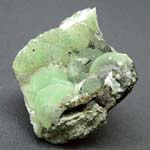
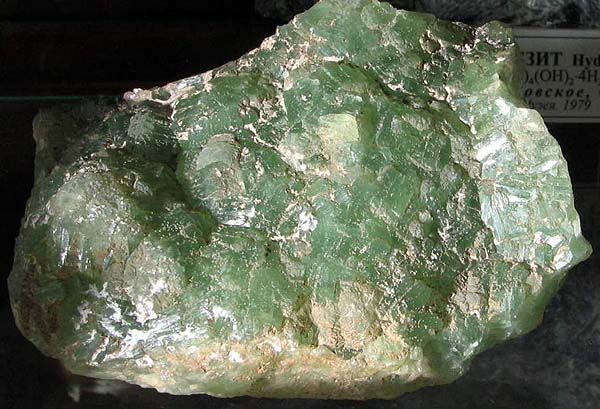
Prehnite. "Cape of Good Hope", south Africa. A photo: © A.A. Evseev.
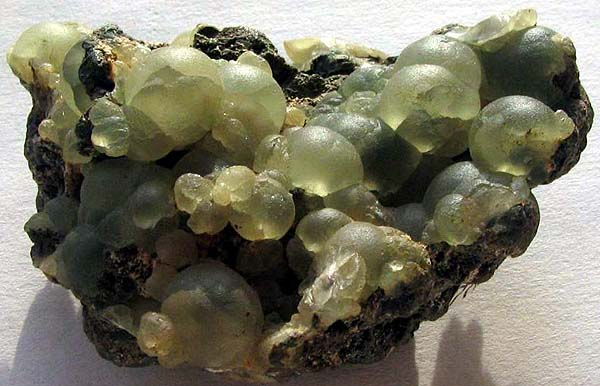
Prehnite. Toningda, Nizh. Tunguska, Russia. CIS. A photo: © A.A. Evseev.
